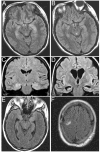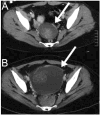Paraneoplastic anti-N-methyl-D-aspartate receptor encephalitis associated with ovarian teratoma
- PMID: 17262855
- PMCID: PMC2430743
- DOI: 10.1002/ana.21050
Paraneoplastic anti-N-methyl-D-aspartate receptor encephalitis associated with ovarian teratoma
Abstract
Objective: To report the autoantigens of a new category of treatment-responsive paraneoplastic encephalitis.
Methods: Analysis of clinical features, neuropathological findings, tumors, and serum/cerebrospinal fluid antibodies using rat tissue, neuronal cultures, and HEK293 cells expressing subunits of the N-methyl-D-aspartate receptor (NMDAR).
Results: Twelve women (14-44 years) developed prominent psychiatric symptoms, amnesia, seizures, frequent dyskinesias, autonomic dysfunction, and decreased level of consciousness often requiring ventilatory support. All had serum/cerebrospinal fluid antibodies that predominantly immunolabeled the neuropil of hippocampus/forebrain, in particular the cell surface of hippocampal neurons, and reacted with NR2B (and to a lesser extent NR2A) subunits of the NMDAR. NR2B binds glutamate and forms heteromers (NR1/NR2B or NR1/NR2A/NR2B) that are preferentially expressed in the adult hippocampus/forebrain. Expression of functional heteromers (not single subunits) was required for antibody binding. Eleven patients had teratoma of the ovary (six mature) and one a mature teratoma in the mediastinum; five of five tumors examined contained nervous tissue that strongly expressed NR2 subunits and reacted with patients' antibodies. Tumor resection and immunotherapy resulted in improvement or full recovery of eight of nine patients (paralleled by decreased antibody titers); two of three patients without tumor resection died of neurological deterioration. Autopsies showed extensive microgliosis, rare T-cell infiltrates, and neuronal degeneration predominantly involving, but not restricted to, the hippocampus.
Interpretation: Antibodies to NR2B- and NR2A-containing heteromers of the NMDAR associate with a severe but treatment-responsive encephalitis. Our findings provide a diagnostic test and suggest a model of autoimmune NMDAR-related encephalitis with broad implications for other immune-mediated disorders of memory, behavior, and cognition.
Figures





Comment in
-
NMDA receptor as a target in paraneoplastic encephalitis.Ann Neurol. 2007 Jan;61(1):3-4. doi: 10.1002/ana.21074. Ann Neurol. 2007. PMID: 17262845 No abstract available.
-
Epitope of autoantibodies to N-methyl-D-aspartate receptor heteromers in paraneoplastic limbic encephalitis.Ann Neurol. 2008 Jul;64(1):110-1; author reply 111-2. doi: 10.1002/ana.21362. Ann Neurol. 2008. PMID: 18350587 No abstract available.
-
Neuroimmunology 2017: making progress over 20 years.Lancet Psychiatry. 2018 Jan;5(1):9-10. doi: 10.1016/S2215-0366(17)30482-0. Lancet Psychiatry. 2018. PMID: 29277216 No abstract available.
References
-
- Gultekin SH, Rosenfeld MR, Voltz R, et al. Paraneoplastic limbic encephalitis: neurological symptoms, immunological findings and tumour association in 50 patients. Brain. 2000;123:1481–1494. - PubMed
-
- Darnell RB, Posner JB. A new cause of limbic encephalopathy. Brain. 2005;128:1745–1746. - PubMed
-
- Graus F, Keime-Guibert F, Rene R, et al. Anti-Hu-associated paraneoplastic encephalomyelitis: analysis of 200 patients. Brain. 2001;124:1138–1148. - PubMed
Publication types
MeSH terms
Substances
Grants and funding
LinkOut - more resources
Full Text Sources
Other Literature Sources
Medical

